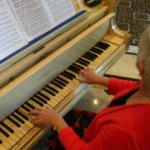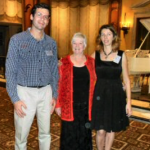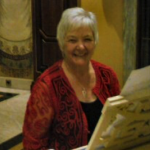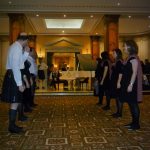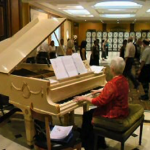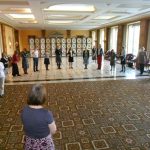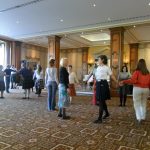
December 2014
The first December Weekend tailor-made for Scottish Country Dancing enthusiasts took place in the magnificent and historic Hotel Palácio Estoril. A gathering of dancers and friends in a picturesque part of Southern Europe, a very international but cosy environment and amazing sunny weather combined to make this event truly unique. The icing of the cake was, without doubt, the incredible live music performed by the famous Scottish pianist, Muriel Johnstone.
Apart from workshops of Scottish Country and Irish Dancing and a traditional Evening Ball, the programme also offered a Portuguese Fado concert, sightseeing tours and a special Ceilidh, with local groups, Portuguese singing and a fabulous modern interpretation of Portuguese folk dances by Folkzitas.
All those elements could be found on original Azulejo-tiles specially hand-painted by local-living Scottish artist Ruth Scott Lindley, who expressed the weekend’s atmosphere in her work.
We enjoyed a unique, warm environment with one, universal, language of communication: DANCE!
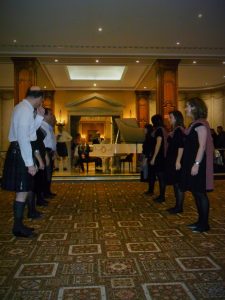
INTERVIEW WITH MURIEL JOHNSTONE
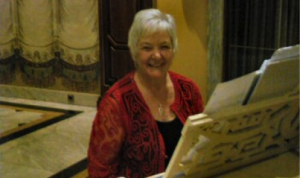
Muriel Johnstone has earned a reputation as one of the finest musicians currently playing for Scottish Dance, both as a solo performer and with other musicians. She has rightly been described as ‘A Keeper of Scottish Tradition’. Muriel began playing piano at the age of seven, and dancing when she was eight. She has played for dancing since 1965, played at RSCDS Summer School since 1975, arranged the music for the Society’s Books 28 to 41, started ‘Scotscores’ in 1984 and has travelled the world since 1988.
She has never lost her enthusiasm for the music and the dance of her native Scotland.
She considers herself to be one of the lucky ones having a career doing something she absolutely loves.
In December 2014 we had the privilege and enormous pleasure to dance to the tunes of Muriel’s fantastic music during our first December Weekend in Portugal. It was called ‘Fado and Scottish Country Dancing’ and took place from December 5-8 in the glamorous Hotel Palácio Estoril.
Muriel accepted Moonluza’s invitation and played not only for our classes, Ball and Ceilidh, but also during a morning session. It was an unforgettable time, bringing immense pleasure to everyone.
Adriana Jurczyk Duarte, Moonluza (AJD): Muriel, was this your first time in Portugal?
Muriel Johnstone (MJ): No, this was my second time in Portugal. The first time I visited the Algarve and Lisbon. This was a trip involving Scottish Country Dancers also. I really loved Portugal so I was very happy to receive the invitation to return to this beautiful country.
AJD: Why do you think Scottish Country Dancing is so popular worldwide? What is so special about it?
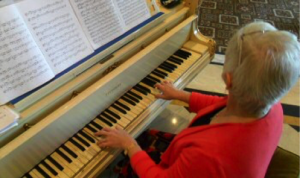
MJ: Being a Scot myself, it is a matter of considerable pride that Scottish Country Dancing has become popular worldwide. There have been many excellent ambassadors for this form of dancing. Some Scots have been very keen to keep the tradition alive whilst living or working abroad and so formed clubs and societies to promote all things Scottish. Teachers of dance have been visiting different parts of the world for many years, passing on the tradition and whipping up enthusiasm. It still seems a little unreal to me that there are at least 35 countries around the world that have formed branches of The Royal Scottish Country Dance Society. What is special about it? I think it is a combination of things and different people are attracted to it for different reasons. Scottish Country Dancing is first of all a social pastime, it requires some use of the brain, it is very good exercise and it is performed to very energising music which is also very beautiful: so it is social, mental, physical and emotional all wrapped up in one!
AJD: Which is your favourite dance? Is there a story behind it?
MJ: How do you pick out a favourite dance when you have been dancing for about 60 years! There are many dances that I enjoy and I just LOVE strathspeys. One of my favourites is The Braes of Breadalbane – a dance that requires a lot of strength and has a powerful strathspey tune in a minor key – heaven! I first learned this dance as a teenager dancing in a young team in a competetive festival. We won – so this has always been a special dance!
AJD: Where do you get the inspiration for your music and dances from?
MJ: I grew up in a small town on the west coast of Scotland across the road from the shore. The first thing I saw every morning was the sea and (when it wasn’t raining!) the island of Arran. I would say that the sea in particular has often been my inspiration for composing music. Other landscapes have also played their part. Right now I am living in the highlands of Scotland with a view of the mountains that is stunning -it is going to be a powerful inspiration. On many occasions I have been asked to write music for a particular person. It is slightly more challenging when I don’t know the person so I have to ask for some details about the character, likes and dislikes, stories that illustrate their nature etc. This is always fun and the reaction from people is so satisfying.


AJD: Who is your favourite musician?
MJ: This is a difficult question since I love so many different forms of music! My favourite Scottish musician is the fiddler Alasdair Fraser.
AJD: What did you think of Moonluza’s first December Weekend?
MJ: I thoroughly enjoyed Moonluza’s first December weekend. It offered something a little bit different from other Scottish Dance weekends. First of all the location was superb. Estoril and the surrounding area is very attractive and Lisbon is easily accessible. The weather was so beautiful I could hardly imagine it was actually December as I strolled along the beach! Hotel Palacio was magnificent – the impressive building, the enormous bed, the huge Christmas tree (decorated with tartan ribbon in our honour!), the marble ballrooms, the fabulous food – I could go on!
There was dancing in class in the morning and social dancing in the evening. In addition we were treated to a concert of Fado singing, Portuguese folk dancing and Irish dancing. There were also two excursions in the afternoon to take in some breathtaking sights. All in all it was an action-packed weekend.
AJD: Is there any chance the inspiration for your next music or dance will come from Portugal?
MJ: There is a chance! I have enough memories, sights and sounds in my head that might just pop out onto the piano one of these days!
Thank you very much for this interview. We are looking forward to seeing you again soon in Portugal!
December 2014
Photo Gallery:




